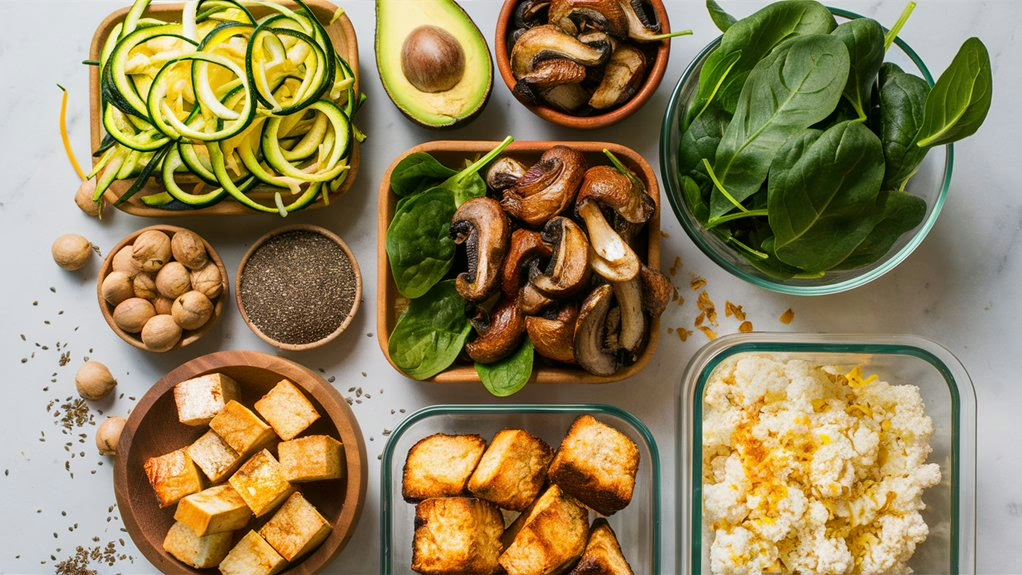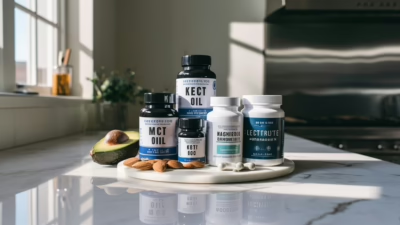A vegan keto diet combines plant-based eating with the high-fat, low-carb principles of ketosis. You’ll focus on getting 70-80% of calories from healthy fats like avocados, coconut oil, and nuts, while keeping your daily carbs between 20-50 grams. Your protein will come from tofu, tempeh, and seeds, making up 15-30% of your diet. This approach can lead to weight loss, improved heart health, and better blood sugar control, though you’ll need to carefully plan your meals to avoid nutritional deficiencies. While it requires dedication to track macros and prepare meals, understanding the fundamentals will set you up for success on your plant-based keto journey.
Understanding Vegan Keto Basics

Combining veganism with the ketogenic diet requires a precise understanding of macronutrient ratios and food choices. When creating your vegan keto meal plan, you’ll need to focus on getting 70-80% of your calories from fat, 15-30% from protein, and only 5% from carbohydrates, keeping your net carbs between 20-50 grams daily.
You’ll want to center your meals around high-fat plant foods like avocados, coconut milk, nuts, and seeds, while incorporating moderate amounts of protein from sources like tofu and tempeh. Non-starchy vegetables, such as leafy greens and broccoli, will become your best friends, as they’re low in carbs but rich in essential nutrients.
It’s crucial to track your macronutrients carefully, using a keto calculator to ensure you’re hitting your targets.
Understanding energy balance principles is essential for achieving successful weight loss on a vegan keto diet.
While this approach can lead to impressive weight loss and potential heart health benefits, you’ll need to be mindful of possible nutritional deficiencies. The diet’s restrictive nature means you’ll need to carefully plan your meals, avoid processed foods, and possibly consider supplements to meet your nutritional needs.
What To Eat
On a vegan keto diet, your food choices must focus on nutrient-dense, high-fat plant foods while keeping carbs minimal.
You’ll want to fill your plate with plenty of non-starchy vegetables like leafy greens, broccoli, and cauliflower, which provide essential nutrients while keeping your carb count low. These versatile veggies can become the foundation of your meals, offering both variety and satisfaction.
When it comes to vegan alternatives on keto, you’ve got several protein-rich options to choose from. Tofu, tempeh, and seitan will become your go-to protein sources, while nuts and seeds like almonds, walnuts, and chia seeds provide both protein and healthy fats.
You’ll also want to incorporate healthy oils into your daily routine, including coconut oil, olive oil, and avocado oil, which can help you meet your fat requirements.
Don’t forget about unsweetened coconut milk and MCT oil, which can add richness to your beverages and meals.
By combining these food groups thoughtfully, you’ll create satisfying meals that maintain ketosis while adhering to vegan principles.
Remember to rotate through different options to ensure you’re getting a wide range of nutrients.
This plant-based approach to eating supports heart health while helping you maintain a healthy weight.
Meal Planning Made Simple

A successful vegan keto diet starts with thoughtful meal planning. You’ll need to track your macronutrients carefully, aiming for 70-80% of calories from fat while keeping your carbs low and protein moderate.
By using meal planning tools and tracking apps, you can make this process much more manageable and ensure you’re hitting your daily targets.
Here’s a simple approach to planning your vegan keto meals:
- Calculate your personal macros using a keto calculator, considering your weight, height, and activity level.
- Create a weekly meal plan focusing on whole foods like avocados, nuts, and leafy greens.
- Prepare meals in advance through batch cooking to stay consistent with your plan.
- Keep emergency snacks handy, such as celery with almond butter or hemp seeds.
When you’re starting your vegan keto journey, it’s helpful to begin gradually and adjust as needed.
You can make delicious meals like chia seed pudding for breakfast, zucchini noodles with avocado sauce for lunch, and cauliflower rice stir-fry for dinner.
Remember to include plenty of variety in your meal plan to prevent boredom and ensure you’re getting diverse nutrients.
Focusing on whole plant-based foods can significantly improve your overall health while maintaining ketosis.
Health Benefits and Risks
The vegan keto diet presents a complex balance of health benefits and potential risks that you’ll need to carefully consider. Following a plant-based keto diet might help you shed unwanted pounds, improve your heart health, and even lower your cancer risk by up to 14%.
You’ll likely see improvements in your blood sugar control and triglyceride levels, making this diet particularly interesting if you’re focused on metabolic health.
Reduced inflammation levels can be achieved through this plant-focused approach to ketogenic eating.
However, you shouldn’t overlook the potential drawbacks. While following this diet, you’re at risk for several nutritional deficiencies, particularly vitamin B12, iron, and calcium.
You might experience the “keto flu” during your transition, which can leave you feeling tired and nauseous. If you’re pregnant, breastfeeding, or have certain health conditions like type 1 diabetes or liver problems, this diet may not be safe for you.
The restrictive nature of combining vegan and keto principles can make long-term adherence challenging, and there’s limited research on its long-term safety.
Getting Started Today

Now that you understand the potential impacts on your health, taking your first steps into vegan keto living requires careful preparation and planning. Starting a low-carb vegan diet doesn’t have to be overwhelming when you break it down into manageable steps.
Understanding balanced nutrition basics helps ensure you’re getting all essential nutrients while following this specialized diet.
Begin by calculating your daily macronutrient needs using a keto calculator, ensuring you’re hitting the target of 70-80% fat, 20-25% protein, and 5-10% carbohydrates.
To make your transition smooth and sustainable, follow these essential steps:
- Clear your pantry of high-carb foods like grains, legumes, and sugary items, replacing them with keto-friendly alternatives such as nuts, seeds, and coconut products.
- Stock up on nutrient-dense, low-carb vegetables like leafy greens, cauliflower, and zucchini to form the foundation of your meals.
- Create a weekly meal plan that incorporates variety and ensures you’re meeting your nutritional needs through carefully chosen vegan protein sources.
- Track your daily intake using a food diary or app, paying special attention to calculating net carbs by subtracting fiber from total carbohydrates.
Remember to transition gradually, allowing your body time to adjust to this new way of eating.
You’ll find it easier to maintain ketosis while following your vegan principles when you’re well-prepared.
Starting a vegan keto diet is not as difficult as you might think, and you’ll find it becomes easier with practice and proper planning. While this lifestyle requires careful attention to your nutritional needs, especially protein and essential nutrients, it’s completely doable with today’s wide variety of plant-based options. Remember to track your macros, stay hydrated, and listen to your body as you transition. If you’re ready for a new dietary adventure that combines ethics and health, vegan keto might be your perfect match.



